Do you have a question about the Husqvarna RZ4621 and is the answer not in the manual?
General information about the manual and product specifications.
Regulations and safety for transporting the machine on public roads.
Cautions and recommendations for towing equipment with the mower.
Guidelines for safe and correct operation of the machine.
Information about Husqvarna's service network and customer support.
Location and importance of manufacturing and serial numbers for parts.
Explains symbols indicating risks of injury, death, or material damage.
Symbols for reverse, neutral, fast, slow, choke, and fuel indicators.
Symbols for parking brake, CE conformity, and do not stand here.
Symbols for protective glasses, gloves, noise, and EMC compliance.
Symbols for manual reading, maintenance safety, and slope operation limits.
Symbols indicating risks from thrown objects, moving parts, and general danger.
Symbols for backing up, moving forward, and hazards near moving blades.
Symbols for battery acid hazards and warnings about rotating blades.
Essential safety guidelines for operating the mower, emphasizing caution.
Rules for safe operation, including clearing area and bystanders.
Precautions regarding alcohol, traffic, loading, eye protection, and age.
Precautions about debris buildup, fuel spillage, and cooling before storage.
Recommended protective gear for safe operation and maintenance.
Guidelines for safe mowing on slopes, including angle limits and turning.
Warnings and procedures to ensure children's safety around the mower.
Procedures for safe refueling and handling of gasoline.
Safety measures to follow during general maintenance tasks.
Safety precautions for handling the battery and its corrosive acid.
Precautions to avoid electrical sparking when working with the battery.
Rules for safe operation, inspection, and using approved parts.
Safety measures for transporting the mower on vehicles or trailers.
Warning about escaping hydraulic oil and necessary precautions.
Requirement for spark arresters in specific environments.
Diagram showing the location of various controls on the machine.
Explanation of how to use steering levers for movement and turning.
How to engage and release the parking brake.
How to adjust engine speed using the throttle control.
How to engage and disengage the mower deck blades.
How to start and stop the engine using the ignition switch.
How to use the choke for cold engine starts.
Information on the location and amperage of the machine's fuses.
Fuel tank capacity, fuel type, and refueling safety precautions.
Location and operation of the fuel shut off valve for transport.
How to adjust the mower deck cutting height for desired results.
How to adjust the operator's seat position for comfort.
How the hour meter displays operating time and maintenance reminders.
How to adjust the tracking knob to ensure straight mower tracking.
Recommendations for new operators of zero-turn mowers.
Detailed instructions on operating steering controls for movement and turning.
Checks and conditions required before starting the engine.
Step-by-step guide to starting the mower's engine.
Setting neutral position, throttle, and choke before starting.
Procedures for turning the ignition key and setting engine speed.
Instructions for jump-starting the mower using jumper cables.
Steps for releasing the brake, setting controls, and engaging the deck.
Safety and operational guidelines for mowing on slopes.
Advice for optimal mowing results and deck maintenance.
Procedures for safely stopping the mower's engine.
Steps for engaging bypass linkages for manual movement or transport.
A comprehensive schedule for daily, weekly, and hourly maintenance tasks.
Specific maintenance tasks and their required intervals.
Safety precautions to follow before performing any maintenance.
Instructions for cleaning, maintaining, and charging the mower battery.
Step-by-step guide for safely replacing the mower battery.
How to verify the proper functioning of the machine's safety system.
Procedures for checking and cleaning the fuel pump's air filter.
Recommended tire pressure for optimal performance and safety.
How to check and adjust the parking brake for proper function.
How to inspect V-belts for wear and cracking.
Instructions for installing and routing the mower deck belt.
Importance of sharp blades and procedures for replacement.
Step-by-step guide for safely replacing mower blades.
How to adjust the mower deck for proper cutting height and leveling.
Proper adjustment of anti-scalp rollers to prevent deck scalping.
Procedures for checking and servicing caster wheels.
Guidelines for cleaning the mower deck and other components.
Daily check for loose or missing hardware.
Chart detailing lubrication points and intervals.
General advice on lubrication, types of grease, and precautions.
How to lubricate the front wheel mounts and bearings.
How to lubricate the deck spindles.
Information on the maintenance-free transmission.
Common problems and causes for engine not starting or running rough.
Common causes of machine vibration.
Causes for engine overheating and battery not charging.
Problems related to slow movement, deck engagement, and leaks.
Factors causing uneven mowing results.
Steps to prepare the machine for long-term storage.
Advice on ordering parts and scheduling annual service.
Electrical schematic diagram of the mower's systems.
Technical details on engine, transmission, and tire specifications.
Technical data related to the mower's frame and physical dimensions.
Technical data for RZ4623 and RZ4824F mower models.
Frame and dimension data for RZ4623 and RZ4824F mower models.
Technical data for RZ5424 mower models.
Frame and dimension data for RZ5424 mower models.
Recommended torque values for various fasteners and bolts.
Information regarding USA requirements and compliance labels.
Checklist for initial delivery service and customer information.
Maintenance tasks to be performed after the first 10 hours of operation.
Maintenance tasks required at the 25-hour interval.
Maintenance tasks required at the 50-hour interval.
Maintenance tasks required at the 100-hour interval.
Maintenance tasks required at the 300-hour interval.
Maintenance tasks to be performed at least once each year.
| Engine Power | 21 hp |
|---|---|
| Cutting Width | 46 inches |
| Fuel Capacity | 3.5 gallons |
| Transmission Type | Hydrostatic |
| Engine | Briggs & Stratton |
| Deck Material | Steel |
| Turning Radius | Zero-turn |
| Cutting Height Range | 1.5 - 4 inches |
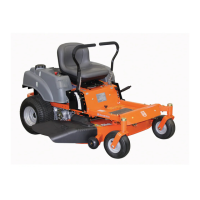

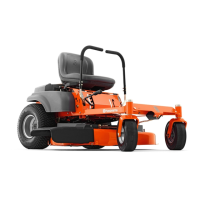


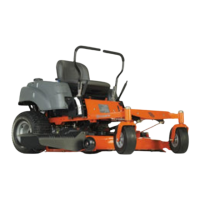
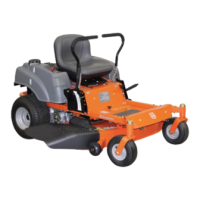

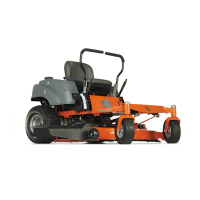



